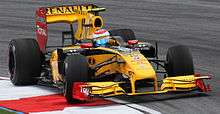Renault R30
.jpg) | |||||||||||
| Category | Formula One | ||||||||||
|---|---|---|---|---|---|---|---|---|---|---|---|
| Constructor | Renault | ||||||||||
| Designer(s) |
James Allison (Technical Director) Tim Densham (Chief Designer)[1] Dirk de Beer (Head of Aerodynamics)[1] | ||||||||||
| Predecessor | Renault R29 | ||||||||||
| Successor | Renault R31 | ||||||||||
| Technical specifications[2][3] | |||||||||||
| Chassis | Moulded carbon fibre and aluminium honeycomb composite monocoque, with engine incorporated as a fully stressed member | ||||||||||
| Suspension (front) | Carbon fibre double wishbone, operating inboard torsion bar and damper units via a pushrod system | ||||||||||
| Suspension (rear) | As front | ||||||||||
| Engine | Renault RS27-2010 2,400 cc (146.5 cu in) 90° V8, limited to 18,000 RPM naturally aspirated mid-mounted | ||||||||||
| Transmission | Seven-speed semi-automatic titanium gearbox with reverse gear "Quickshift" system | ||||||||||
| Weight | 620 kg (1,367 lb) (including driver) | ||||||||||
| Fuel | Total | ||||||||||
| Tyres |
Bridgestone Potenza OZ Wheels (front and rear): 13" | ||||||||||
| Competition history | |||||||||||
| Notable entrants | Renault F1 Team | ||||||||||
| Notable drivers |
11. 12. | ||||||||||
| Debut | 2010 Bahrain Grand Prix | ||||||||||
| |||||||||||
The Renault R30 was a Formula One motor racing car designed and built by Renault for the 2010 season, and was driven by Robert Kubica and rookie Vitaly Petrov. The car was unveiled on January 31, 2010 at the Circuit Ricardo Tormo in Valencia.[4]
At the Belgian Grand Prix, Renault introduced the F-duct on the R30,[5] having been postponed since Silverstone due to inefficiency.[6]

2010 Season
It was immediately obvious that the R30 was more competitive than the R29. Robert Kubica enjoyed a string of strong finishes early in the year and Renault established themselves as the main rivals of Mercedes for 4th in the Constructor's Championship. However, Renault had to settle for 5th by season's end but Kubica's and Vitaly Petrov's double-points-finish in the final race of the year capped off what was an encouraging season for the team which struggled so sorely in 2009.
Pirelli Test Car
A complete chassis was leased to Pirelli for the 2012 Formula One season, to be used by the tyre manufacturer as its test car. The car was tested by Jaime Alguersuari and Lucas di Grassi at several European racetracks, including Jerez, Spa, Monza and Barcelona.
The chassis continued to be used during the 2013 Formula One season.
Complete Formula One results
(key) (results in bold indicate pole position; results in italics indicate fastest lap)
| Year | Entrant | Engine | Tyres | Drivers | 1 | 2 | 3 | 4 | 5 | 6 | 7 | 8 | 9 | 10 | 11 | 12 | 13 | 14 | 15 | 16 | 17 | 18 | 19 | Points | WCC |
|---|---|---|---|---|---|---|---|---|---|---|---|---|---|---|---|---|---|---|---|---|---|---|---|---|---|
| 2010 | Renault F1 Team | Renault RS27 V8 | B | BHR | AUS | MAL | CHN | ESP | MON | TUR | CAN | EUR | GBR | GER | HUN | BEL | ITA | SIN | JPN | KOR | BRA | ABU | 163 | 5th | |
| Robert Kubica | 11 | 2 | 4 | 5 | 8 | 3 | 6 | 7 | 5 | Ret | 7 | Ret | 3 | 8 | 7 | Ret | 5 | 9 | 5 | ||||||
| Vitaly Petrov | Ret | Ret | Ret | 7 | 11 | 13† | 15 | 17 | 14 | 13 | 10 | 5 | 9 | 13 | 11 | Ret | Ret | 16 | 6 |
† Driver failed to finish the race, but was classified as they had completed >90% of the race distance.
References
- 1 2 Cooper, Adam (2010-02-04). "Renault R30". Autosport. Vol. 199 no. 5. pp. 64–67.
- ↑ "Renault F1 R30 Technical Specifications". renaultf1.com. Renault F1. Retrieved 2010-01-31.
- ↑ "Renault F1 RS27 Technical Specifications". renaultf1.com. Renault F1. Retrieved 2010-01-31.
- ↑ Elizalde, Pablo (2010-01-31). "Renault reveals the R30, confirms Petrov". autosport.com. Haymarket Publications. Retrieved 2010-01-31.
- ↑ English, Steven; Noble, Jonathan (2010-08-30). "Renault delighted by F-duct performance". autosport.com. Haymarket Publications. Retrieved 2010-09-02.
- ↑ "No F-Duct For Renault". PaddockTalk.com. Paddock Talk. 2010-07-08. Retrieved 2010-10-23.
External links
| Wikimedia Commons has media related to Renault R30. |